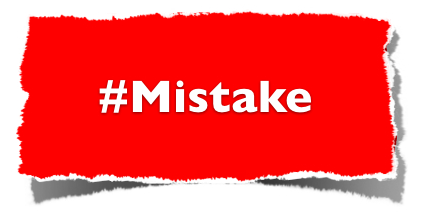Lolly Daskal

We all make mistakes. And if we’re smart, we’re able to turn those mistakes into insight and their consequences into wisdom. But some mistakes are so disastrous that the most important lesson they impart is “Never do that again!” Here are some of the biggest mistakes that successful leaders make—but only once.
1. Playing safe. It’s ironic that when a leader plays it safe they’re actually making one of the biggest mistakes in the book. When you stop taking risks, you stop being bold, and great leadership needs courage and boldness to succeed.
2. Taking shortcuts. There can be no cutting corners when it comes to your leadership or your business. Trying to do something faster and cheaper instead of better and more innovative will end up costing you greatly. It’s a hard mistake to come back from, even once.
3. Overpromising and underdelivering. One of the golden rules for any business is to underpromise and overdeliver. When you cross those wires, the results are usually catastrophic and long-lasting enough to be an effective deterrent against a repeat. Make a commitment only when you’re certain you can meet expectations.
4. Not asking tough questions. Being a successful leader means you have to ask the tough questions. When you fail to do so, you’re underprepared for whatever situation you walk into—plus you have a reputation for being either unconcerned or timid.
5. Losing sight of the big picture. It’s easy to lose sight of what you are trying to achieve when times are hectic and everything feels frantic, but as a successful leader you have to quickly correct perspectives and keep everyone’s eyes on your mission. Holding your goals at the forefront of everything you do will take you far.
6. Blaming others. Assigning blame when something goes wrong is one of the most destructive actions you can take, something that costs you greatly in respect and trust. Successful people earn respect by being personally accountable. And when something goes wrong, they focus on solving the problem instead of finding someone to take the fall.
7. Being deceitful. Lies tend to multiply quickly, and they’re incredibly hard to maintain. Once you’ve been caught deceitful, your personal reputation suffers grave harm, and your entire leadership is damaged.
8. Not asking for help. No one ever became successful without the support and assistance of others, but we often make the mistake of thinking we have to do it all on our own. We all need a helping hand, and we all need to be willing to help others as well.
9. Leading with perfectionism. No matter how many times you tell a person that there’s no such thing as perfection, it’s still built into the nature of many people to aim for it. When you lead with perfectionism, you miss the chance to model for those people the essence of achievement—the importance of striving for excellence, not perfection, for meaning, not flawlessness.
10. Trying to please everyone. We all want to be well liked. But successful people learn early on that it’s impossible to make everyone happy. Everyone has an opinion, and some people will never be pleased no matter how hard you try. Successful people know that trying to please everyone makes them less effective—which means making more people unhappy.
Lead from within: It’s not the mistake but what we learn from it that ends up defining us.

